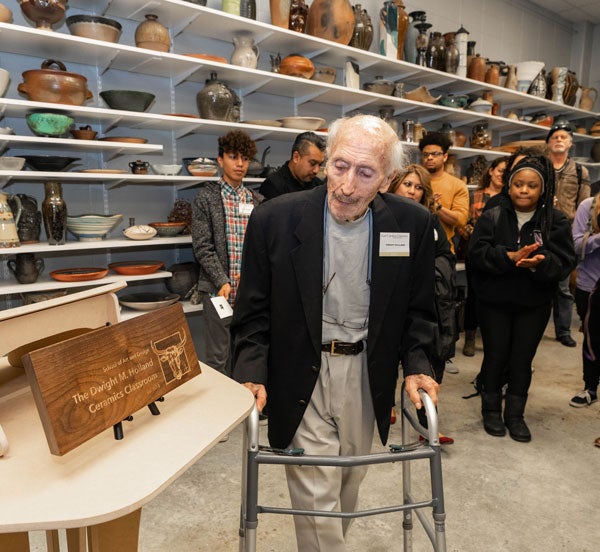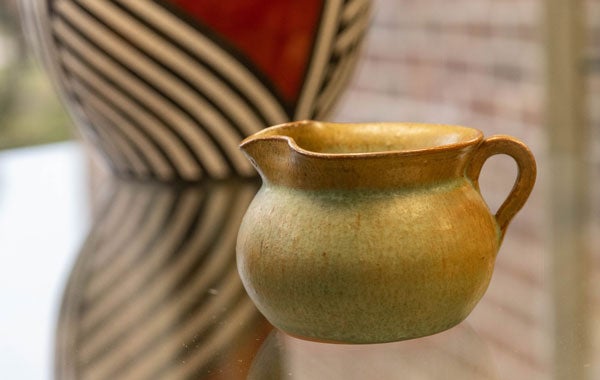CERAMIC COLLECTION
Pieces get an accessible home in School of Art and Design

Dwight Holland stands near the plaque that was made in honor of Holland’s ceramic collection he donated to ECU 20 years ago.
School of Art and Design students at East Carolina University now have access to a unique ceramics art teaching tool through a gift by former Asheboro art teacher and N.C. Zoo curator Dwight M. Holland.
In 1998, Holland approached school officials about donating his extensive collection of pottery and contemporary ceramics. Holland’s interest was to provide a hands-on experience to ECU students and others through gifting ceramic works that are ordinarily placed in “untouchable” museum collections. He has continued his donations to the collection for 20 years.
On Nov. 14, the school celebrated the opening of the newly-named Dwight M. Holland Ceramics Classroom where the pieces will be housed. Students will learn from the actual collectable and valuable objects about the design, utility and embellishment of ceramic art. The ECU Board of Trustees approved the classroom name on Nov. 2.
“While teaching collections are not new, the Dwight M. Holland Ceramics Teaching Collection and its location and access is innovative because the collection is visually open and accessible for students rather than them selecting a few pieces from art storage to work with,“ said Kate Bukoski, School of Art and Design director. “This space embodies the vision of Dwight Holland and other donors — that students have hands-on access to excellent ceramics regularly, where they can learn by touch, sight and discussion and then go in the studio to make, applying insights and ideas inspired by the collection.”
Holland’s love for making and collecting ceramics started with his connection to the traditional potters of Seagrove, North Carolina. He chose ECU as the home for his collection because its School of Art and Design emphasizes both traditional art making and a progressive multi-disciplinary approach in art education.

Holland has been donating pieces from his extensive collection of pottery and contemporary ceramics since 1998.
“I have known the art and design school at East Carolina University for over 50 years and have watched the ceramic program grow — I felt the program had stability and longevity, so I made the university an offer to give them my collection … if they agreed to certain conditions,” said Holland in an article in Ceramics Monthly. “The most important condition is that the collection would be a teaching collection and must be housed in or near the ceramics department.
“Students must have access to the collection and be able to handle and study the pots.”
At the event, Holland stressed the importance of being able to pick up a piece rather than just seeing a photograph. “To this day, I like running my fingers down in a pot and feeling the throwing rings,” he said. “You can’t get that from a slide or photograph. You have to touch it.”
The collection includes an assortment of master works. Many of the early Seagrove-area works illustrate very simple and humble dirt dishes, while later examples include art ware made during Prohibition when pottery was shipped from Seagrove on mule drawn carts. Contemporary pieces include ceramic artists from countries as distant as Russia and Estonia as well as many famous American ceramicists and potters.
“There are wonderful stories I could tell because pots are made by people,” Holland said.
Other collectors have joined Holland in donating significant works of ceramic art to the teaching collections, and the ECU School of Art and Design now houses more than 2,000 objects made by artists from around the world. The collections contain donations by Holland, James R. Henderson, Margaret Pepper Fluke, Benjamin F. Keaton, Lawrence W. S. Auld and Baltic Ceramic Arts.
While the collection’s primary mission is to serve students, it is viewable by the public by appointment. Contact eos@ecu.edu or 252-328-6281 for more information.

Laura Bauza looks at pottery in the Holland collection.
